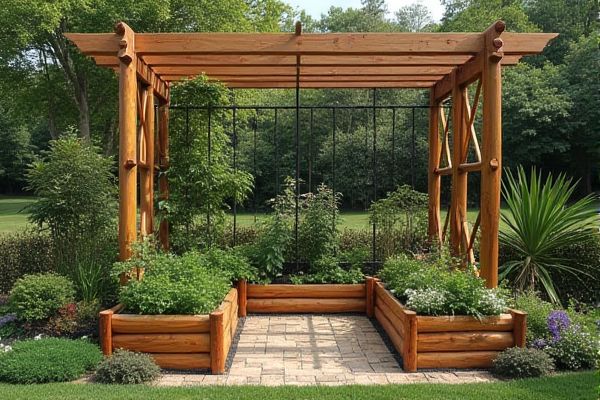
Log raised beds offer a natural, rustic aesthetic and excellent insulation for plant roots, while metal raised beds provide durability, modern appeal, and resistance to pests and rot. Discover which option best suits Your gardening needs and preferences by reading the full comparison in the article.
Table of Comparison
| Feature | Log Raised Bed | Metal Raised Bed |
|---|---|---|
| Material | Natural wood logs | Galvanized or stainless steel |
| Durability | Moderate; prone to rot and insect damage | High; rust-resistant and long-lasting |
| Maintenance | Requires periodic treatment or replacement | Low maintenance; occasional cleaning |
| Appearance | Rustic, natural look | Modern, sleek design |
| Cost | Generally affordable | Typically higher initial investment |
| Environmental Impact | Biodegradable but may involve deforestation | Recyclable metal; energy-intensive manufacturing |
| Installation | Simple assembly, may require cutting logs | Easy assembly with pre-fabricated panels |
| Heat Retention | Good insulation, maintains soil warmth | Metal heats up quickly but cools fast |
Introduction: Log Raised Beds vs Metal Raised Beds
Log raised beds offer natural insulation and excellent moisture retention, promoting healthier root growth and reducing the need for frequent watering. Metal raised beds provide durability, resistance to pests, and a modern aesthetic, often lasting longer without warping or rotting. Choosing between log and metal depends on factors like climate, budget, and garden style preferences.
Aesthetic Appeal and Garden Design
Log raised beds offer a natural, rustic aesthetic that blends seamlessly with woodland or cottage garden designs, enhancing organic visual harmony. Metal raised beds provide a sleek, modern look with clean lines and durability, complementing contemporary or industrial garden styles. Both options can be strategically integrated to elevate overall garden aesthetics through texture contrast and material variety.
Durability and Lifespan Comparison
Log raised beds offer natural durability with resistance to rot when treated or made from hardwoods like cedar, lasting approximately 10-15 years. Metal raised beds, typically constructed from galvanized steel or aluminum, provide superior lifespan exceeding 20 years due to their rust-resistant coatings and structural strength. Choosing metal raised beds can optimize Your garden's longevity with minimal maintenance compared to the natural wear of log materials.
Installation and Assembly Process
Log raised beds offer a straightforward installation process, requiring minimal tools and basic skills to stack and secure the logs, making them ideal for DIY enthusiasts. Metal raised beds often feature pre-drilled holes and interlocking panels, enabling faster assembly but sometimes needing specialized tools like drills or screws. Your choice between log and metal raised beds depends on your comfort level with tools and desired assembly speed.
Soil Temperature Regulation
Log raised beds provide superior soil temperature regulation due to the natural insulating properties of wood, which helps maintain consistent warmth beneficial for plant root growth. In contrast, metal raised beds tend to absorb and retain heat rapidly, causing soil temperatures to fluctuate more drastically, potentially stressing plants during extreme weather. Choosing log raised beds can create a more stable microclimate conducive to healthy plant development.
Maintenance and Upkeep Requirements
Log raised beds require regular maintenance to prevent rotting, insect damage, and weathering, often needing treatments or sealants to extend their lifespan. Metal raised beds offer low upkeep, as they resist decay and pests, though they may need occasional rust prevention or touch-ups of protective coatings. Both options benefit from periodic inspection, but metal raised beds generally demand less frequent care.
Cost and Budget Considerations
Log raised beds typically have a lower initial cost due to the availability of natural wood materials, making them budget-friendly for DIY gardeners. Metal raised beds, while often more expensive upfront, offer greater durability and longevity, potentially reducing long-term replacement costs. Your choice depends on balancing immediate budget constraints with the desire for a longer-lasting garden structure.
Sustainability and Environmental Impact
Log raised beds offer natural biodegradability and often utilize sustainably sourced wood, reducing environmental impact through renewable materials. Metal raised beds, while durable and recyclable, require energy-intensive manufacturing processes that contribute more to carbon emissions. Your choice depends on prioritizing eco-friendly decomposition or long-term material reuse.
Pest and Disease Resistance
Log raised beds naturally deter pests due to their organic composition, which can harbor beneficial microorganisms that suppress harmful insects and diseases. Metal raised beds offer resistance to rot and fungal infections but may create a microenvironment that attracts certain pests if not properly managed. Choosing log beds enhances soil biology for disease resistance, while metal beds require more vigilant pest control measures to maintain plant health.
Best Use Cases and Final Recommendations
Log raised beds offer excellent durability and natural insulation, making them ideal for gardeners seeking an eco-friendly option that blends seamlessly with outdoor landscapes. Metal raised beds provide superior longevity and resistance to pests and rot, perfect for urban or modern garden settings where space efficiency and low maintenance are priorities. Your choice depends on whether you prioritize natural aesthetics and insulation (log) or sleek design and minimal upkeep (metal).
 homyna.com
homyna.com